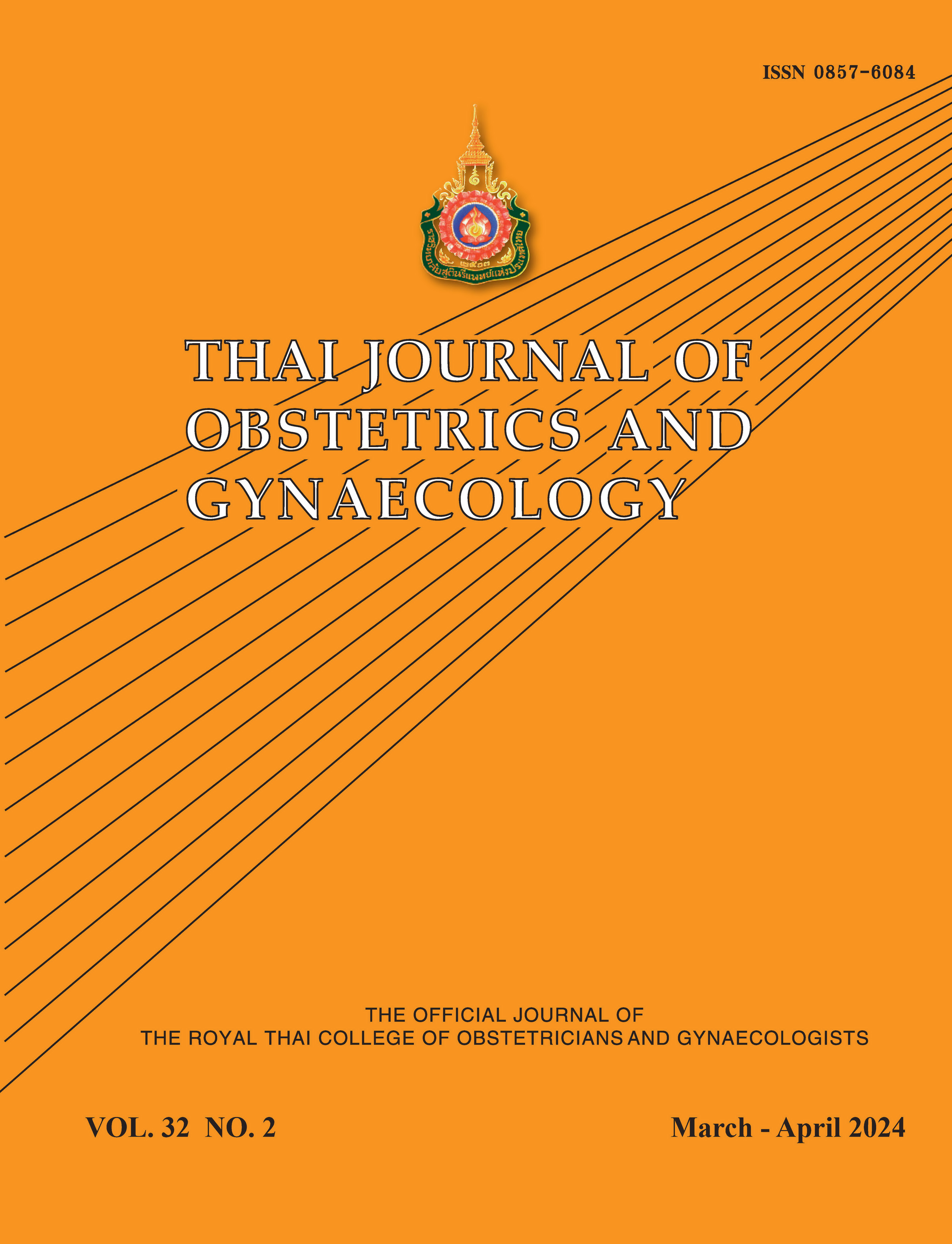Risk Assessment of Endometrial Hyperplasia and Cancer in Premenopausal Women with Abnormal Uterine Bleeding
Main Article Content
Abstract
Objectives: Our goal was to develop an endometrial sampling protocol for the early detection and treatment of endometrial hyperplasia and endometrial cancer (EH/EC) in premenopausal women experiencing abnormal uterine bleeding.
Materials and Methods: A prospective cohort study on premenopausal women with abnormal uterine bleeding who underwent endometrial sampling was conducted at Ratchaburi Hospital. Each patient’s risk factors and conducted clinical assessments, including pelvic examinations and transvaginal ultrasound were documented. To determine the likelihood of EH/EC, univariate and stepwise logistic regression analyses were used.
Results: Among 200 eligible premenopausal women with abnormal uterine bleeding who received endometrial sampling, histological analysis identified EH in 14 women (7%) and EC in 7 women (3.5%). Stepwise logistic regression revealed a significant association of EH/EC with a body mass index of 30 kg/m2 or higher, tamoxifen usage, and an endometrial thickness exceeding 10 mm (p = 0.004, 0.041, and 0.001, respectively). The presence of two or three of these risk factors significantly increased the association with EH/EC (p < 0.001).
Conclusion: Obesity, tamoxifen usage, and endometrial thickness greater than 10 mm were strong indicators of EH/EC. Endometrial sampling is recommended for patients exhibiting more than one of these risk factors.
Article Details

This work is licensed under a Creative Commons Attribution-NonCommercial-NoDerivatives 4.0 International License.
References
Whitaker L, Critchley HO. Abnormal uterine bleeding. Best Pract Res Clin Obstet Gynaecol 2016;34:54-65.
Mishra D, Sultan S. FIGO’s PALM–COEIN Classification of abnormal uterine bleeding: a clinico-histopathological correlation in Indian Setting. J Obstet Gynaecol India 2017;67:119-25.
Rizzo S, Femia M, Buscarino V. Endometrial cancer: An overview of novelties in treatment and related imaging keypoints for local staging. Cancer Imaging 2018;18:45-52.
Giannella L, Mfuta K, Setti T, Bergamini E, and Boselli F. A risk-scoring model for the prediction of endometrial cancer among symptomatic postmenopausal women with endometrial thickness > 4 mm. Bio Med Res Int 2014;69:135-42.
Hanegem N, Breijer M, Khan K. Diagnostic evaluation of the endometrium in postmenopausal bleeding: an evidence-based approach. Maturitas 2011;68:155–64.
Kim M, Kim J. Endometrial evaluation with transvaginal ultrasonography for the screening of endometrial hyperplasia or cancer in premenopausal and perimenopausal women. Obstet Gynecol Sci 2016;59:192-7.
Van den Bosch T, Ameye L, Bourne T, Timmerman D. Intra-cavitary uterine pathology in women with abnormal uterine bleeding: a prospective study of 1220 women. Facts Views Vis Obgyn 2015;7:17–24.
Clarke MA, Long BJ, Del Mar Morillo A, Arbyn M, Bakkum-Gamez JN, Wentzensen N. Association of endometrial cancer risk with postmenopausal bleeding in women: a systematic review and meta-analysis. JAMA Intern Med 2018;178:1210-22.
Pennant ME, Mehta R, Moody P, Hackett G, Prentice A, Sharp SJ, Lakshman R. Premenopausal abnormal uterine bleeding and risk of endometrial cancer. BJOG 2017;124:404-11.
Clarke MA, Long BJ, Sherman ME, Lemens MA, Podratz KC, Hopkins MR. A prospective clinical cohort study of women at increased risk for endometrial cancer. Gynecol Oncol 2020;156:169-77.
American College of Obstetricians and Gynecologists. ACOG committee opinion no. 557: management of acute abnormal uterine bleeding in nonpregnant reproductive-aged women. Obstet Gynecol 2013;121:891-6.
ACOG committee opinion no. 734: the role of transvaginal ultrasonography in evaluating the endometrium of women with post-menopausal bleeding. Obstet Gynecol 2018;131:124-9.
Akira M, Takashi U, Shinsuka H, Makio S. Prospective evaluation of abnormal glucose metabolism and insulin resistance in patients with atypical endometrial hyperplasia and endometrial cancer. Support Care Cancer 2017;25:1495-501.
Bartlett JE, Kotrlik JW, Higgins CC. Organizational Research: Determining Appropriate Sample Size in Survey Research 2018;19:43-50.
Suwanwanich M. Relative risk factor of abnormal endometrial pathologies in patients with abnormal uterine bleeding. J Dept Med Serv 2019; 44:103-7.
Fortner RT, Hüsing A, Kühn R, Konar M, Overvad K, Tjønneland A, Hansen L. Endometrial cancer risk prediction including serum based biomarkers: results from the EPIC cohort. Int J Cancer 2017;140:10–23.
Wise M, Gill P, Lensen S, Tompson J, Farquhar M. Body mass index trumps age in decision for endometrial biopsy: cohort study of symptomatic premenopausal women. Am J Obstet Gynecol 2016;215:589-98.
Megan A, Beverly J, Mark E, Maureen A. Risk assessment of endometrial cancer and endometrial intraepithelial neoplasia in women with abnormal bleeding and implications for clinical management algorithms. Am J Obstet Gynecol 2020;223:549:1-13.
Giannella L, Cerami L, Setti T, Bergamini E, Boselli F. Prediction of endometrial hyperplasia and cancer among premenopausal women with abnormal uterine bleeding. Biomed Res Int 2019;2019:8598152.


